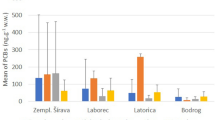Abstract
This study was conducted to assess the health of a subtidal marine sculpin, Myoxocephalus scorpius, naturally exposed in a shipping terminal where polychlorinated biphenyls (PCBs) had been spilled, as well as that of others sculpins after decontamination in the laboratory for 16 weeks. Reference samples were captured at a pristine site upcurrent from the contaminated terminal. Examination of field samples caught by scuba divers showed external and toxicopathic lesions in several tissues; decreased body condition and organ indices; and decreased hemoglobin and lymphocyte levels. No difference in the diversity of parasites was observed between reference and contaminated samples, but abundance was generally greater in fish from the latter site. Although the total number of species of parasites decreased in both groups of depurated sculpins, the abundance of infections on gill and gall bladder was significantly greater in fish from the polluted site. These results suggest that M. scorpius was affected adversely by PCBs and that its responses are ecologically significant as a bioindicator species in degraded habitats. Moreover, remediation might not mitigate the observed anomalies in fish inhabiting the impacted site.
Similar content being viewed by others
References
Barker DE, Khan RA, Lee EM, Hooper RG, Ryan K (1994) Anomalies in sculpins (Myoxoesphalus spp.) near a pulp and paper mill. Arch Environ Contam Toxicol 26:491–496
Barnthouse LW, Glaser D, DeSantis L (2009) Polychlorinated biphenyls and Hudson River white perch: implications for population-level ecological risk assessment and risk management. Integr Environ Assess Manag 5:435–444
Dick T, Chambers C, Gallagher CP (2009) Parasites, diet and stable isotopes of shorthorn sculpin (Myoxocephalus scorpius) from Frosbisher Bay, Canada. Parasite 16:297–304
Ennis GP (1970) Age, growth and sexual maturity of the shorthorn sculpin, Myoxocephalus scorpius, in Newfoundland waters. J Fish Res Board Can 27:2155–2158
Goksoyr A, Beyer J, Egaas E, Grosvik BE, Hylland KM, Skaare JU et al (1996) Biomarker responses in flounder (Platichthys flesus) and their use in pollution monitoring. Mar Pollut Bull 33:36–45
Jones KC, de Voogt P (1999) Persistent organic pollutants (POPs): state of the science. Environ Pollut 100:209–221
Khan RA (1999) Length-mass relationship, histopathology and parasitism in winter flounder (Pleuronectes americanus) living near a PCB-contaminated naval facility in Newfoundland. Can J Zool 77:381–388
Khan RA (2003) Health of flatfish from localities in Placentia Bay, Newfoundland, contaminated with petroleum and PCBs. Arch Environ Contam Toxicol 44:485–492
Khan RA, Billiard SM (2007) Parasites of winter flounder (Pleuronectes americanus) as an additional biomarker of stress-related exposure to untreated pulp and paper mill effluent: a 5-year study. Arch Environ Contam Toxicol 52:243–250
Khan RA, Hooper RG (2000) Depuration of winter flounder (Pleuronectes americanus) following chronic exposure to effluent from a pulp and paper mill. Arch Environ Contam Toxicol 38:197–201
Khan RA, Nag K (1993) Estimation of hemosiderosis in seabirds and fish exposed to petroleum. Bull Environ Contam Toxicol 51:125–131
Khan RA, Payne JF (2002) Some factors influencing EROD activity in winter flounder (Pleuronectes americanus) exposed to effluent from a pulp and paper mill. Chemosphere 46:235–239
Khan RA, Payne JF (2004) Comparative study of oil well drill cuttings and polycyclic aromatic hydrocarbons on parasitism in winter flounder: a dose response study. Bull Environ Contam Toxicol 73:652–658
Khan RA, Thulin J (1991) Influence of pollution on parasites of aquatic animals. Adv Parasitol 30:201–238
Lindesjöö E, Thulin J (1990) Fin erosion of perch Perca fluviatilis and ruffe Gymnocephalus cernua in a pulp mill effluent area. Dis Aquat Organ 8:119–126
Macdonald TE, Margolis L (1995) Synopsis of the parasites of fishes of Canada: supplement (1978-1993). Canadian special publication of fisheries & aquatic sciences
MacKenzie K, Williams HH, Williams B, McVicar AH, Siddall R (1995) Parasites as indicators of water quality and the potential use of helminth transmission in marine pollution studies. Adv Parasitol 35:85–144
Marcogliese DJ, Nagler JJ, Cyr DG (1998) Effects of exposure to contaminated sediments on the parasitic fauna of American plaice (Hippoglossoides platessoides). Bull Environ Contam Toxicol 61:88–95
Monosson E (1999) Reproductive and developmental effects of PCBs in fish: summary of laboratory and field studies. Rev Toxicol 3:25–75
Polyanskii YuI (1955) Parasites of fish of the Barents Sea [English translation]. Zoologisch Instit Akad Nauk SSSR, 158 pp
Reiser DW, Greenberg ES, Helser TE, Branton M, Jenkins KD (2004) In situ reproduction, abundance and growth of young-of-the-year and adult largemouth bass in a population exposed to polychlorinated biphenyls. Environ Toxicol Chem 23:1762–1774
Sanchez-Ramirez C, Vidal-Martinez VM, Aguirre-Macedo L, Rodriguez-Canul RP, Ceja-Morena V, Gold-Bouchot G et al (2007) Cichlidogyrus sclerosus (Monogenea: Ancyrocephalinae) and its host the Nile tilapia (Oreochromis niloticus) as bioindicators of chemical pollution. J Parasitol 93:1097–1106
Scott WB, Scott MG (1988) Atlantic fishes of Canada. Can Bull Fish Aquat Sci 219:731
Sulgostowaska T, Jerzewska B, Wicikowski J (1990) Parasite fauna of Myoxocephalus scorpius (L.) and Zoarces viviparus (L.) from environs of Hel (south-east Baltic) and seasonal occurrence of parasites. Acta Parasitologa Polonica 35:143–148
Underwood AJ (2000) Importance of experimental design in detecting and measuring stresses in marine populations. J Aquat Ecosyst Stress Recovery 7:3–24
Williams HH, MacKenzie K (2003) Marine parasites as pollution indicators: an update. Parasitology 126(Suppl):S27–S41
Acknowledgments
This study was supported by funding from the Natural Sciences and Engineering Council of Canada. I am grateful to S. Wall for preparing the manuscript for publication and to two anonymous referees for suggestions for revising the manuscript.
Author information
Authors and Affiliations
Corresponding author
Rights and permissions
About this article
Cite this article
Khan, R.A. Chronic Exposure and Decontamination of a Marine Sculpin (Myoxocephalus scorpius) to Polychlorinated Biphenyls Using Selected Body Indices, Blood Values, Histopathology, and Parasites as Bioindicators. Arch Environ Contam Toxicol 60, 479–485 (2011). https://doi.org/10.1007/s00244-010-9547-9
Received:
Accepted:
Published:
Issue Date:
DOI: https://doi.org/10.1007/s00244-010-9547-9




